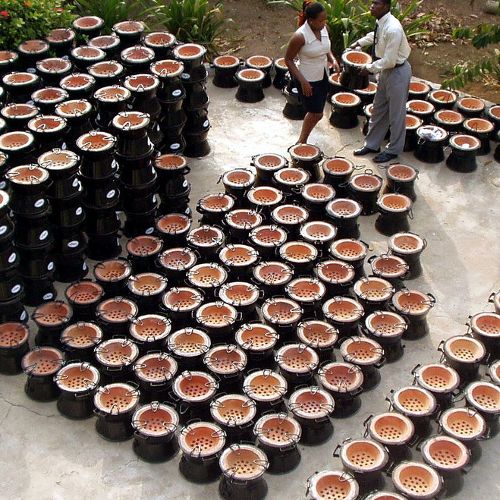Reducing Indoor Air Pollution - Accra, Ghana
| Location | Accra, Ghana, West Africa |
|---|---|
| Pollutant | Indoor Air Pollution (carbon dioxide, particulate matter). |
| Cause | Burning of biomass (wood, charcoal, dung, crop residue) for cooking |
| Health Impact | Cooking fumes lead to an estimated 1.5 to 2 million deaths worldwide according to a 2000 report [1]. |
| Output | To address the health effects of indoor air pollution due to cooking with biomass, the Gyapa stoves project has created an innovative commercialization scheme for producing and distributing an improved cooking stove, coupled with a campaign to drive demand by raising awareness of the health risks posed by indoor air pollution and teaching women how to cook traditional foods with the new stoves. be relocated. These components include medical clinics, therapy camps, family clubs, and micro-lending programs. |
| Outcome | In 2008, 68,000 stoves were sold in Accra and Kumasi, potentially providing cleaner indoor air for approximately 400,000 people, including approximately 160,000 children. PM10 levels in the air decreased by 40 to 45 percent through use of the stoves [2]. |
| Implications | Many projects have focused on improving the stove technology to reduce pollutants. Uniquely, this program, because of its innovative strategy toward creating a sustainable business model, has gone the next step in gaining widespread use by creating a self-sustaining market and supply chain. Project partners expect 100,000 additional stoves to be sold in 2009. |
| Remaining Challenges | The Gyapa stove confronts issues of pricing, manufacturing, and quality control. |
Context
The most significant cause of indoor air pollution in the developing world is the burning of coal or unprocessed biomass fuels for cooking, heating and light. More than 50 percent of the world’s population gets their energy for cooking in this way, with almost all of these people living in impoverished countries [3].
In the West African nation of Ghana, the majority of the population relies on biomass (wood, charcoal, dung and crop residue) for cooking, causing high concentrations of smoke and carbon dioxide in traditional homes. In 2000, the World Bank estimated that 95 percent of Ghanaian households used solid fuels to power stoves, a much higher portion than the 73.4 percent estimate for Africa’s Northwestern quadrant [4]. Worldwide, the burning of solid fuels is thought to be the largest source of indoor air pollution, and 80 percent of global exposure to such pollution occurs in developing nations [5].
As noted in the 2008 World’s Worst Polluted Places Report, biomass fuels are typically burned in rudimentary stoves. Importantly, few of these fully combust the fuel, therefore resulting in inefficient use of precious fuel and unnecessarily large amounts of air emissions [6]. The high amount of emitted particulate coupled with usually poor ventilation produces indoor concentrations of toxic fumes, which pose families at health risks. Those most affected are women, who do most of the cooking, as well as infants, who are often times strapped to the backs of their mothers.
Site Details
Rural Ghanaian homes are generally small and often consist of one or two rooms. They are generally poorly insulated and ventilated. Cooking may take place inside or outside the home over a traditional clay stove or an open fire, fueled by savannah wood or other biomass; this use of solid fuels increases indoor air pollution as wood smoke freely passes into living spaces or into other homes. The use of wood as cooking fuel not only harms the inhabitants’ health, but is also recognized as a factor in deforestation, soil erosion, loss of soil fertility, and ecosystem imbalance [7].
Health Impact
The effects of indoor air pollution range from acute respiratory infections, chronic obstructive pulmonary disease, lung cancer and asthma, to nasopharyngeal and laryngeal cancer. It also contributes to cataracts, blindness, and perinatal risks such as stillbirth, low birth weight, prematurity and early infant death.
In 2000, between 1.5 and 2 million deaths worldwide were caused by indoor air pollution. This represents 4 to 5 percent of global mortality for that year [8].
Children under five, young girls and women are most severely affected: they spend most of their time at home near the stove, while husbands and elder children are at work or in school.
The US Environmental Protection Agency recommends the daily average concentration of smaller particulate matter (PM10, < 10 μm in diameter) be no more than 150 μg/m³. In comparison, homes in which solid fuel is used for cooking can reach concentration levels as high as 5,000 μg/m³. A child sitting directly next to a stove may breathe air containing up to 50,000 μg/m³ of noxious matter [9].
Exposure Pathways
Indoor Air Pollution mostly affects health through inhalation, but can also affect the eyes through contact with smoke. It happens largely in the household where cooking, sleeping, eating and other activities take place. Household members who help cook meals generally stand directly over the stove, inhaling smoke throughout the process, although anyone within the enclosed space is also affected. The burning of biomass fuels adds to airborne particulate levels. Particles with diameters of less than 10 microns (PM10), and particularly those less than 2.5 microns in diameter (PM2.5), are small enough to penetrate deeply into the lungs [10].
Intervention
EnterpriseWorks Ghana, Shell Foundation and USAID have partnered since 2002 to find a solution to Ghana’s indoor air pollution problem. Initially targeting the two main cities in the country, Accra and Kumasi, the Gyapa Charcoal and Wood Stoves project aimed to reduce smoke and particulate matter levels in urban and rural households by developing a sustainable supply chain for improved cook stoves and raise awareness of the health risks posed by indoor air pollution.
Gyapa stoves, named after the Ghanaian word for “good fire,” are charcoal-burning stoves. They are a version of the Rocket stove design, but fitted with a ceramic liner to improve fuel efficiency. The project partners found that air quality improved 40 to 45%, and that children under five were 25% less likely to die from respiratory diseases [11]. An independent study comparing the traditional stove with the Gyapa stove found that average 24-hour PM2.5 concentrations decreased 52% from 65μg/m3 after introduction of the new stove to 320 μg/m3 in the ‘after’ phase (p = 0.00), and average 24-hour kitchen CO concentrations decreased 40% from 12.3 ppm to 7.4 ppm (p = 0.01). 24-hour average CO levels in households using the Gyapa stoves met, or nearly met, the World Health Organization (WHO) 8-hour Air Quality Guideline. Despite these advances, PM2.5 concentrations remained well above the WHO 24-hour guideline [12].
Many stove designs have been developed to replace traditional open cooking fires to reduce indoor air pollution, and these designs are still evolving. The important innovation of the current project is the partners’ focus on developing an entrepreneurial, market-driven model to support the manufacture, distribution and use of the stoves. A network of local craftspeople and entrepreneurs profitably manufactures the metal stoves and ceramic liners and distributes them to retailers. Meanwhile demand is being driven by a public awareness campaign on the health effects of cooking fires. Care is also taken to instruct women on how to adjust their traditional cooking techniques to the new stove. EnterpriseWorks/VITA initially provided capital for suppliers to invest in the necessary materials and trained local metal workers and ceramicists to build the Gyapa. Partners also provided customer care, quality control and business advice.
Sales for 2008 were 68,000 with 2009 sales projected at 100,000. Meanwhile the venture provides income to over 400 individuals.
Remaining Challenges
Indoor air pollution remains as a significant health risk in the developing world. In the Ghana case, the Gyapa stove confronts issues of pricing, manufacturing, and quality control. There is a high demand for skilled ceramicists and raw material in the manufacturing process, posing challenges in technology and investment transfers to the developing country. Moreover, implementing organizations also experience challenges in distributing the product on a large scale.
Implementing Organizations
EnterpriseWorks/VITA, USAID, Shell Foundation, US Environmental Protection Agency, JPMorgan/ClimateCare, Center for Entrepreneurship in International Health and Development (UC Berkeley), Aprovecho Research Center, Columbia University, Industrial Research Institute (CSIR Ghana), Ministry of Energy, Ghana.
References
Bruce, N., et al. Indoor biofuel air pollution and respiratory health: the role of confounding factors among women in highland Guatemala. International Journal of Epidemiology. 1998: 27: 454-458.
Bruce, N.G., Perez-Padilla R, Albalak R. The health effects of indoor air pollution exposure in developing countries. Geneva, World Health Organization, 2002. (WHO/SDE/OEH/02.05).
→ http://whqlibdoc.who.int/hq/2002/WHO_SDE_OEH_02.05.pdf
Ezzati, M., and Kemmer, D.M. 2002. The health impacts of exposure to indoor air pollution from solid fuels in developing countries: knowledge, gaps, and data needs. Environmental Health Perspectives: 110 (11).
Ministry of Local Government and Rural Development, Ghana. Ghana Districts--A repository of all districts in the Republic of Ghana. 2006. 2 Oct. 2009.
→ http://www.ghanadistricts.com/districts/?r=7&_=126&sa=4604
Pennise D, et al. Indoor air quality impacts of an improved wood stove in Ghana and an ethanol stove in Ethiopia. Energy for Sustainable Development, 13(2), June 2009.
Smith K, Mehta S, Maeusezahl-Feuz M. Indoor air pollution from household use of solid fuels. In: Ezzati M, Lopez A, Roders A et al. Comparative Quantification of Health Risks, Global and Regional Burden of Disease Attributable to Selected Major Risk Factors, Geneva, World Health Organization, 2004.
Smith, K.R. Indoor air pollution in developing countries: recommendations for research. Indoor Air 2002, 12(3): 198-207.
Titiati, A. Commercializing Stove Technologies. EnterpriseWorks/VITA. Presentation, Partneship for Cleaner Indoor Air Forum. 2 Oct. 2009. Retrieved Sept. 15, 2009 from
→ http://www.pciaonline.org/files/Titiati_Commercialization_Stoves.pdf.
World Health Organization. Indoor Air Pollution and Household Energy Directory of References. 2009. Retrieved 2 Oct. 2009 → http://www.who.int/heli/risks/indoorair/indoorairdirectory/en/index.html
Additional Photos
 |
| Commercial distribution of improved stoves helps reduce respiratory illness due to cooking fires. Credit: EnterpriseWorks/VITA |
Footnotes
[1] Ezzati, M., and Kemmer, D. M. 2002.
→ http://ehp.niehs.nih.gov/members/2002/110p1057-1068ezzati/EHP110p1057PDF.PDF
[2] Titiati, A. Retrieved Sept. 15, 2009 from
→ http://www.pciaonline.org/files/Titiati_Commercialization_Stoves.pdf
[3] World Health Organization. 2009. Indoor Air Pollution and Household Energy Directory of References. Retrieved 2 Oct. 2009
→ http://www.who.int/heli/risks/indoorair/indoorairdirectory/en/index.html
[4] Smith K, Mehta S, Maeusezahl-Feuz M. Indoor air pollution from household use of solid fuels. In: Ezzati M, Lopez A, Roders A et al. Comparative Quantification of Health Risks, Global and Regional Burden of Disease Attributable to Selected Major Risk Factors, Geneva, World Health Organization, 2004. pp. 1435-1494. → http://www.who.int/publications/cra/chapters/volume2/1435-1494.pdf
[5] Smith, K.R. Indoor air pollution in developing countries: recommendations for research. Indoor
Air 2002: 12: 198-207.
[6] Bruce, N., et al. Indoor biofuel air pollution and respiratory health: the role of confounding factors among women in highland Guatemala” International Journal of Epidemiology. 1998: 27: 454-4583 ibid
[7] → http://www.ghanadistricts.com/districts/?r=7&_=126&sa=4604, retrieved October 22, 2009
[8] Ezzati, M., and Kemmer, D. M. 2002.
[9] Ibid.
[10] Bruce, N., et al. Indoor biofuel air pollution and respiratory health: the role of confounding factors among women in highland Guatemala” International Journal of Epidemiology. 1998: 27: 454.
[11] Titiati.
[12] Pennise D, et al. Indoor air quality impacts of an improved wood stove in Ghana and an ethanol stove in Ethiopia. Energy for Sustainable Development, 132, June 2009, p.

-
Phasing Out Leaded Gasoline
-
Ending Chemical Weapons
-
Improving Indoor Air - Ghana
-
Preventing Mining Pollution - Chile
-
Lowering Radioactivity - Chernobyl
-
Cleaning Urban Air - India
-
Removing Lead - Dom. Republic
-
Recapturing Mercury - Indonesia
-
Reducing Lead - Russia
-
Removing DDT - Tanzania
-
Restoring a Waterway - China
-
Removing Arsenic - India



